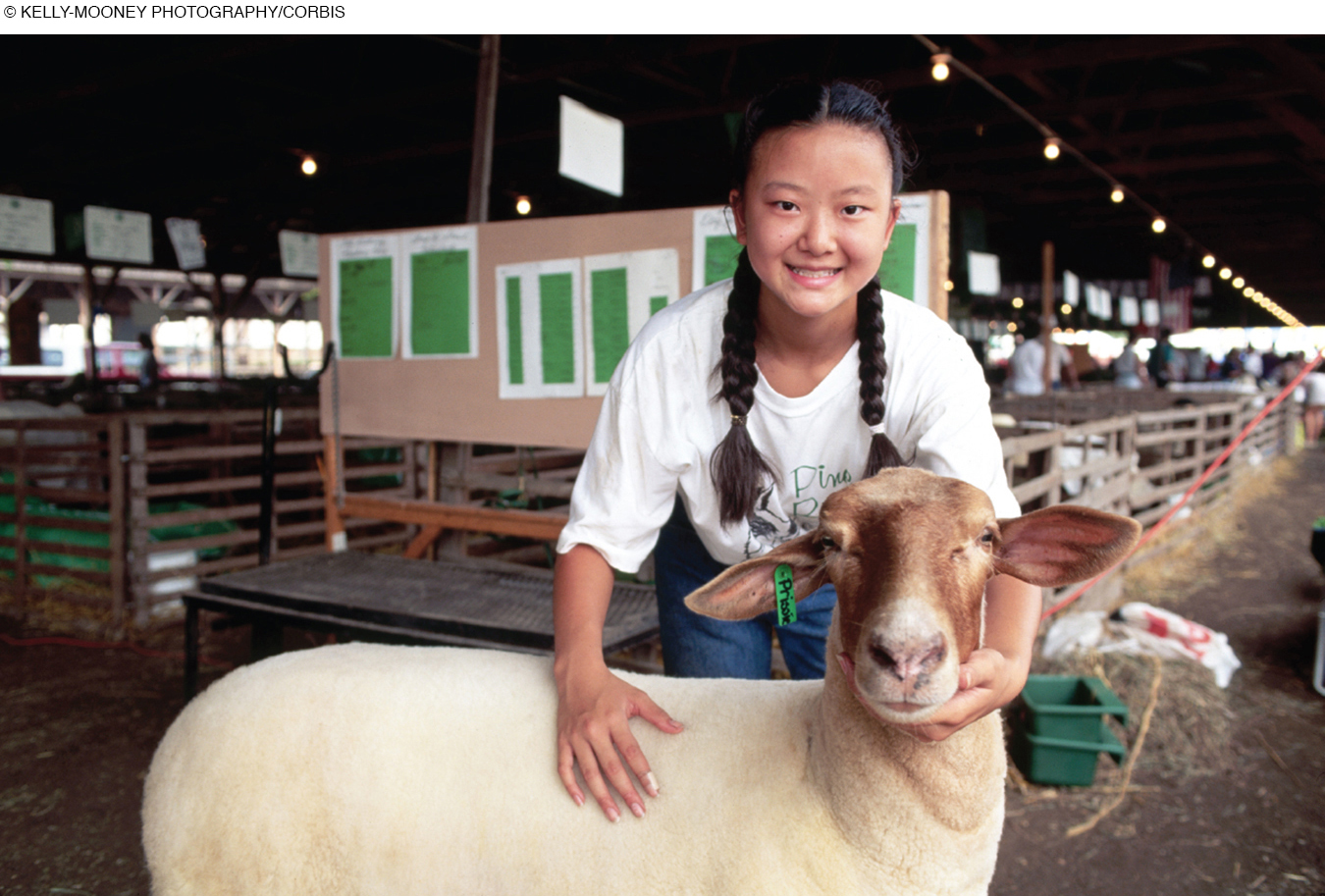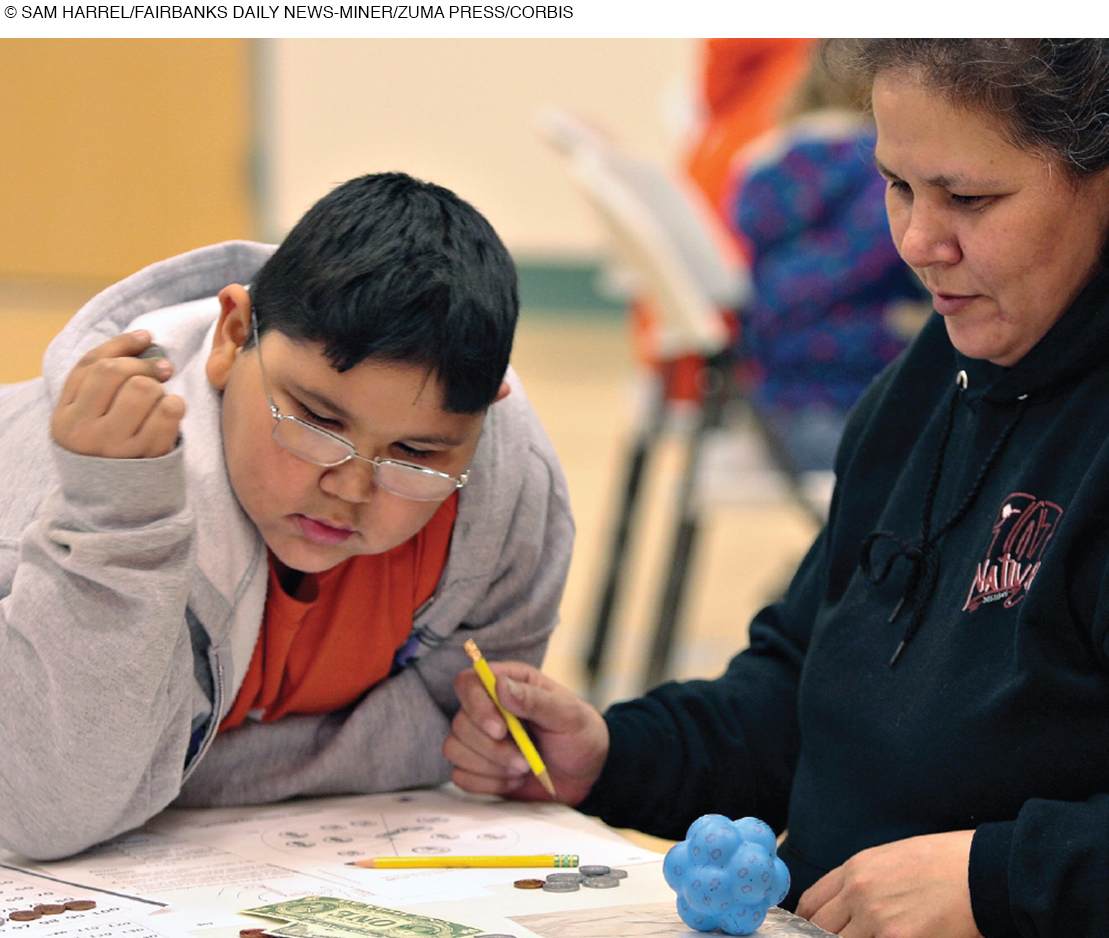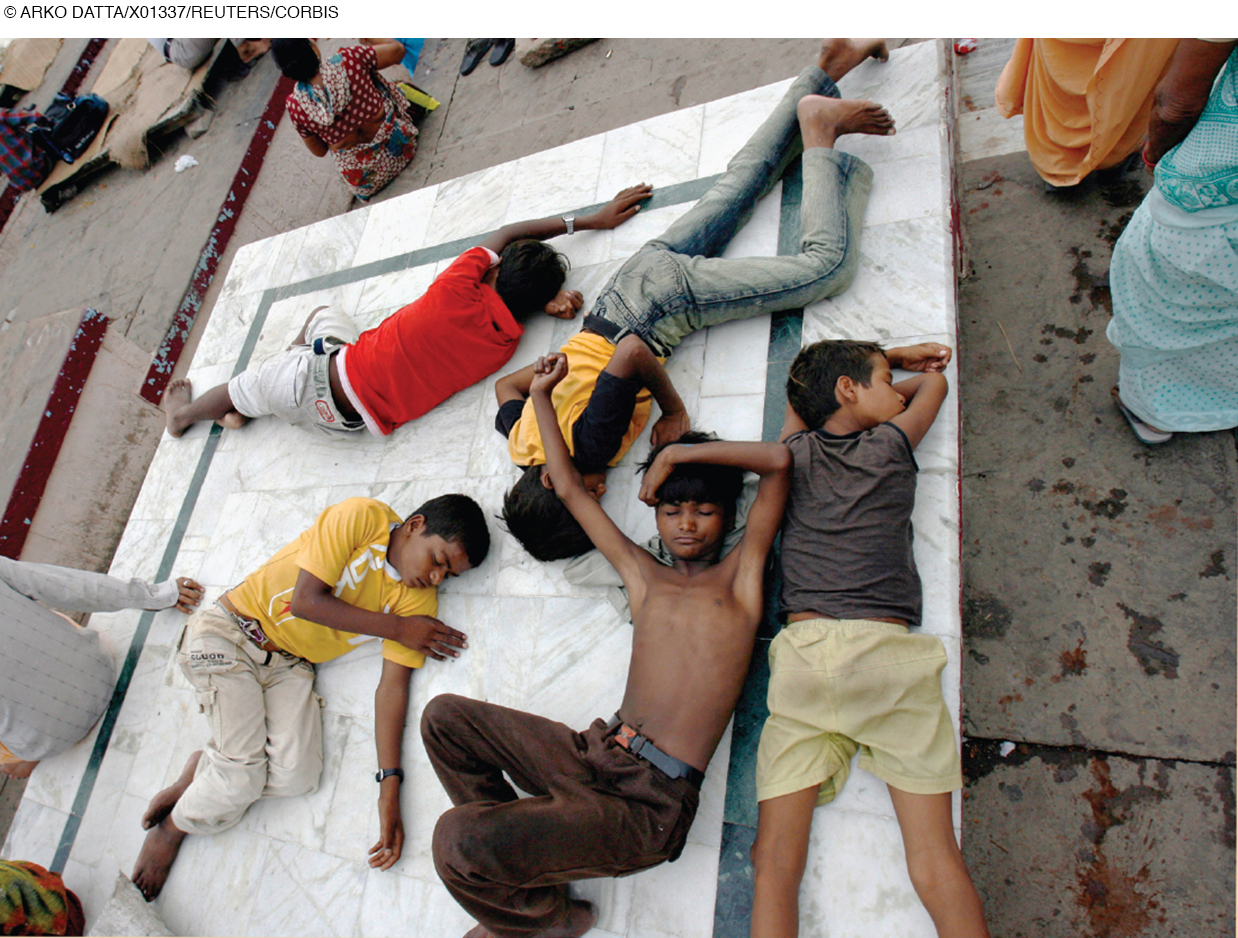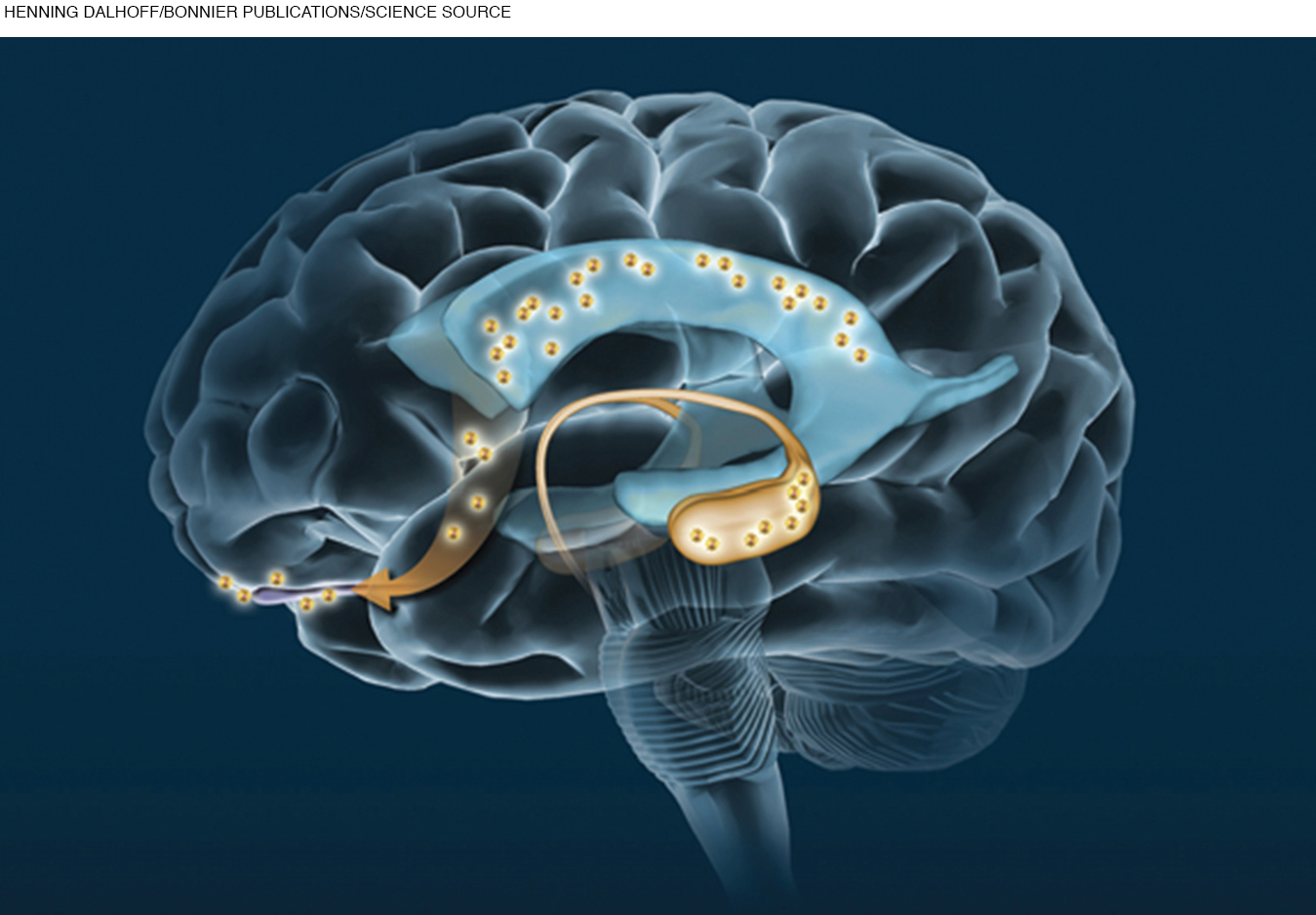Cognition
Learning is rapid. Some children, by age 11, beat their elders at chess, play music that adults pay to hear, publish poems, or solve complex math problems. Others survive on the streets or fight in civil wars. Children can learn almost anything. Adults must decide how and what to teach.

Piaget in Middle Childhood
concrete operational thought
Piaget’s term for the ability to reason logically about direct experiences and perceptions.
Piaget called cognition during these years concrete operational thought, characterized by new concepts that enable children to be logical. Operational comes from the Latin word operare, meaning “to work; to produce.” By calling this period operational, Piaget emphasized productive thinking.
The school-
classification
The logical principle that things can be organized into groups (or categories or classes) according to some characteristic they have in common.

ADVANCES IN LOGIC One logical operation is classification, organizing things into groups (or categories or classes) according to some characteristic. For example, family includes parents, siblings, and cousins. Other common classes are animals, toys, and food. Each class includes some elements and excludes others; each is part of a hierarchy.
Food, for instance, is an overarching category, with the next-
Piaget devised many classification experiments. For example, a child is shown a bunch of nine flowers—
Until about age 7, most children answer, “More daisies.” The youngest children offer no justification, but some 6-
seriation
The concept that things can be arranged in a logical series, such as the number series or the alphabet.
In addition to classification, two other logical concepts (i.e., conservation and reversibility) were mentioned in Chapter 5. Piaget described a fourth concept, seriation, the realization that things can be arranged in a logical series. Seriation is crucial for using (not merely memorizing) the alphabet or the number sequence.

Video Activity: The Balance Scale Task shows children of various ages completing the task and gives you an opportunity to try it, too.
By age 5, most children can count up to 100. However, because they do not yet grasp seriation, they may be unable to estimate where any particular two-
BRAIN CONNECTIONS Brain scans were not available to Piaget, but it is easy to see that his understanding of logic was prescient, reflecting what we now know as brain maturation. As children grow older, connections form between the various lobes and regions of the brain. Such connections are crucial for the complex tasks that children must master, which require “smooth coordination of large numbers of neurons” (P. Stern, 2013, p. 577).
Certain areas of the brain, called hubs, are locations where massive numbers of axons meet. Hubs tend to be near the corpus callosum, and damage to them correlates with brain dysfunction, as in dementia (now called neurocognitive disorders) and schizophrenia (Crossley et al., 2014).
Particularly important are links between the hypothalamus and the amygdala, because emotions need to be regulated so that learning can occur. Stress impairs these connections: Slow academic mastery is one more consequence of early maltreatment (Hanson et al., 2015).
On the other hand, the development of many logical concepts, including classification as Piaget described it, depends on neurological pathways from the general (food) to the particular (bacon) and back again. Those paths are not forged until brain maturation allows connective links in the hubs.
One example of the need for brain connections is learning to read, perhaps the most important intellectual accomplishment of middle childhood. Reading is not instinctual: Our ancestors never did it, and until recent centuries, only a few scribes and scholars could make sense of marks on paper. Consequently, the brain has no areas dedicated to reading, the way it does for talking or gesturing (Sousa, 2014).
Instead, reading uses many parts of the brain—
Indeed, every skill, every logical idea, every thought suddenly applied from one circumstance to another requires connections between many neurons. As Piaget recognized, a cascade of new intellectual concepts results when connections allow a logical idea to be applied to many specifics.
Vygotsky and the Social Context
Like Piaget, Vygotsky felt that educators should consider children’s thought processes, not just the outcomes. He appreciated children as curious, creative learners. He wrote that rote memorization rendered the child “helpless in the face of any sensible attempt to apply any of this acquired knowledge” (Vygotsky, 1994a, pp. 356–
THE ROLE OF INSTRUCTION Unlike Piaget, Vygotsky stressed teaching. He thought that learners need a bridge between developmental potential and necessary skills via guided participation and scaffolding, within the zone of proximal development (all concepts already explained).

Confirmation of the role of instruction comes from a U.S. study of children who, because of their school’s entry-
Internationally as well, children who begin school earlier tend to be ahead in academic achievement compared to those who enter later, an effect still evident when the children were in high school. But we shouldn’t be too quick to decide that early schooling is necessary. As the author of this study noted, there are many possible explanations, and early schooling did not advance later learning in every nation (Sprietsma, 2010).
Remember that Vygotsky believed that education occurs everywhere, not just at school. He would not be surprised that fifth-
Families (e.g., parents read to them daily when they were toddlers)
Preschools (with a variety of learning activities)
First-
grade curriculum (e.g., emphasizing literacy, with individualized instruction)
In this study, most children from families of low SES did not experience all three sources of stimulation, but those who did showed more cognitive advances by fifth grade than the average high-
selective attention
The ability to concentrate on some stimuli while ignoring others.
Perhaps the most important role of teachers is to help children focus. Selective attention, the ability to concentrate on some stimuli while ignoring others, improves markedly at about age 7. For example, many new readers confuse the letters b, d, and p—which are actually all the same, a small circle connected to a line. An astute mentor is needed to call the child’s attention to the placement of that line.
Similar crucial distinctions are present in every script, not just Roman ones—
School-
For example, children in school listen, take notes, and ignore distractions (all difficult at age 6, easier by age 10). Ignoring the din of the cafeteria, children react quickly to gestures and facial expressions. On the baseball diamond, mentors (coaches and teammates) teach batters to ignore attempts to distract them and teach fielders to move into position as soon as the bat hits the ball. That’s selective attention, guided by culture and the brain, as the prefrontal cortex continues to mature.

INTERNATIONAL CONTEXTS Vygotsky’s emphasis on sociocultural contexts contrasts with Piaget’s maturational, self-
Context affects more than academic learning. A stunning example of knowledge acquired from the social context comes from Varanasi, a city in northeast India. Many Varanasi children have an extraordinary sense of spatial orientation. In one experiment, children were blindfolded, spun around, and led to a second room, yet many still knew which direction was north (Mishra et al., 2009). How did they know? Consider social context.
In Varanasi, everyone refers to direction to locate objects. The English equivalent might be that the dog is sleeping not by the door but southeast. From their early days, children learn north/south/east/west. By middle childhood, they have internalized a sense of direction.
Many studies in the United States validate that the social context shapes what and how children learn. The process is reciprocal: Children are eager to learn, and that drives them to learn in whichever manner their culture presents.
THINK CRITICALLY: If some children learn by observation, some by direct instruction, and some by hands-
For example, children who are used to learning by observation (as in some American Indian cultures) are better at remembering overheard folktales than children who expect direct instruction (Tsethlikai & Rogoff, 2013). Again, Vygotsky would not be surprised.
Information Processing

Educators and psychologists regard both Piaget and Vygotsky as insightful. International research confirms the merits of their theories.
A third approach to understanding cognition adds crucial insight. The information-
Thousands of researchers who study cognition benefit from the information-
(1) Select relevant units of information (as a search engine does),
(2) Analyze and connect (as software programs do), and
(3) Express their conclusions so that another person can understand (as a networked computer or a printout might do).
By tracing the paths and links of these neurological functions, scientists track learning. The brain’s gradual growth, increasingly seen in detailed scans, confirms the usefulness of the information-
LEARNING MATH One of the leaders of the information-
Instead, math knowledge accrues gradually. New and better strategies for calculation are tried, ignored, half-
One example is the ability to estimate where a number might fall on a line, such as where the number 53 would be placed on a line from 0 to 100. This skill gradually builds from the first grade on, predicting later math skills (Feigenson et al., 2013). Understanding the size of fractions (e.g., that  is smaller than ¼) may also be crucial, as this predicts later math achievement in many nations (Torbeyns et al., 2015). Some other early math achievements (such as counting to 100) do not correlate with math achievement, an interesting finding from information-
is smaller than ¼) may also be crucial, as this predicts later math achievement in many nations (Torbeyns et al., 2015). Some other early math achievements (such as counting to 100) do not correlate with math achievement, an interesting finding from information-
Video: Arithmetic Strategies: The Research of Robert Siegler
MEMORY Many scientists who study memory take an information-
sensory memory
The component of the information-
Sensory memory (also called the sensory register) is the first component of the human information-
working memory
The component of the information-
Once some sensations become perceptions, the brain selects the meaningful ones and transfers them to working memory for further analysis. It is in working memory (formerly called short-
Processing, not mere exposure, gets information into working memory. As Siegler’s waves metaphor suggests, strategies for processing information do not appear suddenly. Children gradually develop ways to increase working memory (Camos & Barrouillet, 2011). For this reason, working memory improves markedly in middle childhood (Cowan & Alloway, 2009) (see Table 7.1).
| Child’s Age | Memory Capabilities |
|---|---|
| Under 2 years | Infants remember actions and routines that involve them. Memory is implicit, triggered by sights and sounds (an interactive toy, a caregiver’s voice). |
|
2– |
Words are now used to encode and retrieve memories. Explicit memory begins, although children do not yet use memory strategies. Children remember things by rote (their phone number, nursery rhymes) without truly understanding them. |
|
5– |
Children realize that some things should be remembered, and they begin to use simple strategies, primarily rehearsal (repeating an item again and again). This is not a very efficient strategy, but with enough repetition, automatization occurs. |
|
7– |
Children use new strategies if they are taught them. Children use visual clues (remembering how a particular spelling word looks) and auditory hints (rhymes, letters), evidence of brain functions called the visual– |
|
9– |
Memory becomes more adaptive and strategic as children become able to learn various memory techniques from teachers and other children. They can organize material themselves, developing their own memory aids. |
| Information from Meadows, 2006. | |
Cultural differences are evident. For example, many Muslim children are taught to memorize all 80,000 words of the Quran, so they learn strategies unknown to non-
long-
The component of the information-
Finally, information from working memory may be transferred to long-
Crucial to long-
Memory depends on review and repetition, with the learner engaged in practice that involves thought (not mindless review) (Brown et al., 2014). Memories fade unless the information is processed. Children might memorize 3 × 9 = 27, but without processing, they might not know how many Valentine’s Day candies to buy to give three to each of their nine friends.
knowledge base
A body of knowledge in a particular area that makes it easier to master new information in that area.

THE MORE YOU KNOW . . . Research on information processing finds that the more people know, the more they can learn. Having an extensive knowledge base, or a broad body of knowledge, makes it easier to remember and understand related new information.
Three factors affect the knowledge base: past experience, current opportunity, and personal motivation. The last item in this list explains why children’s knowledge base is not what their parents or teachers would choose. Some schoolchildren memorize words and rhythms of hit songs, know plots and characters of television programs, or recite the names and histories of basketball players. Yet they do not know whether World War I was in the nineteenth or twentieth century or whether Pakistan is in Asia or Africa.
control processes
Mechanisms (including selective attention, metacognition, and emotional regulation) that combine memory, processing speed, and knowledge to regulate the analysis and flow of information within the information-
metacognition
“Thinking about thinking,” or the ability to evaluate a cognitive task in order to determine how best to accomplish it and then to monitor and adjust one’s performance on that task.
CONTROL PROCESSES Memory, processing speed, and the knowledge base come together via control processes, which regulate analysis and flow of information. Control processes are related to metacognition, which is an understanding of one’s own learning. The better a person is at metacognition, the more efficient their control processes become.
According to scholars of cognition, “Middle childhood may be crucial for the development of metacognitive monitoring and study control processes” (Metcalfe & Finn, 2013, p. 19). Metacognition can be considered the ultimate control process because a person can evaluate a learning goal, decide how to accomplish it, monitor performance, and finally adjust effort to make sure it is accomplished.
Control processes require the brain to organize, prioritize, and direct mental operations, much as the CEO (chief executive officer) of a business organizes, prioritizes, and directs business operations. For that reason, control processes are also called executive processes, and the ability to use them is called executive function (already mentioned in Chapter 5).
Executive function improves each year of middle childhood (Masten, 2014; Bjorklund et al., 2009). For example, unlike first-

Older children can decide to do their homework before watching television or to review their spelling words before breakfast, creating mnemonics to remember the tricky parts. They can anticipate what teachers will ask. All these signify executive function.
The Maturing Brain


Video Activity: Brain Development: Middle Childhood depicts the changes that occur in a child’s brain from age 6 to age 11.
Recall that emotional regulation, theory of mind, and left–
Maturation of the prefrontal cortex—
reaction time
The time it takes to respond to a stimulus, either physically (with a reflexive movement such as an eyeblink) or cognitively (with a thought).
THINK QUICK; TOO SLOW Advance planning and impulse control are aided by faster reaction time, which is how long it takes to respond to a stimulus. Increasing myelination reduces reaction time every year from birth until about age 16. Skill at games is an obvious example, from scoring on a video game, to swinging at a pitch, to kicking a speeding soccer ball toward a teammate.
Many more complex examples involve social and academic skills. For instance, being able to calculate when to utter a witty remark and when to stay quiet is something few 6-
Both quick responses and quick inhibition develop. Children become less likely to blurt out wrong answers but more likely to enjoy games that require speed. Interestingly, children with reading problems are slower as well as more variable in reaction time, and that itself slows down every aspect of reading (Tamm et al., 2014).
automatization
A process in which repetition of a sequence of thoughts and actions makes the sequence routine, so it no longer requires conscious thought.
AUTOMATIC PROCESSING One final advance in brain function in middle childhood is automatization, when a sequence of thoughts and actions is repeated so often that it seems to be automatic. Firing one neuron sets off a chain reaction, just as saying a few words brings to mind an entire phrase.
Consider again learning to read. At first, eyes (sometimes aided by a guiding finger) focus intensely, painstakingly making out letters and sounding out each one. This slowly leads to the perception of syllables and then words. Eventually, the process becomes so routine that people driving along a highway read billboards that they have no interest in reading. Children do the same, gradually learning to read without conscious control.
Automatic reading aids other academic skills. One longitudinal study of second-
WHAT HAVE YOU LEARNED?
Question 7.9
1. Why did Piaget call cognition in middle childhood concrete operational thought?
Children this age can apply logic to concrete (tangible) things. They cannot yet deal with abstractions or hypothetical situations.
Question 7.10
2. What might be examples of classification in a category not listed in the text, such as transportation or plants?
Ground transportation could be classified as vehicles, mass transit, trains, or bicycles. Plants could be classified as edible and non-
Question 7.11
3. How do Vygotsky and Piaget differ in their explanation of cognition in middle childhood?
Piaget contended that cognitive advances occur naturally, as a result of maturation and self-
Question 7.12
4. How are the children of Varanasi an example of Vygotsky’s theory?
Many Varanasi children have an extraordinary sense of spatial orientation. In Varanasi, everyone refers to direction to locate objects. From their early days, children learn north/south/east/west; by middle childhood, they have internalized a sense of direction.
Question 7.13
5. How does selective attention make it easier for a child to sit in a classroom?
Selective attention is the ability to concentrate on some stimuli while ignoring others. This helps school-
Question 7.14
6. What does information processing add to traditional theories of cognitive development?
The basic assumption of the information processing approach is that, like computers, people can access large amounts of information. They seek specific units of information, analyze, and express their conclusions.
Question 7.15
7. How does Siegler describe the process of learning math concepts?
Siegler compared the acquisition of knowledge to waves on a beach when the tide is rising. There is substantial ebb and flow, although eventually a new level is reached.
Question 7.16
8. What aspects of memory improve markedly during middle childhood?
Working memory—
Question 7.17
9. Why does the knowledge base increase in middle childhood?
Three factors affect the knowledge base: past experience, current opportunity, and personal motivation. These factors are greater in middle childhood than ever before, allowing knowledge base to increase during this time.
Question 7.18
10. How might advances in control processes and executive function help a student learn?
Control processes help a student learn because they require the brain to organize, prioritize, and direct mental operations. The ability to use them is called executive function. Executive function improves each year of middle childhood; for example, unlike first-
Question 7.19
11. Why does quicker reaction time improve the ability to learn?
Increasing myelination reduces reaction time every year from birth until about age 16. Faster reaction time helps students develop quicker responses and inhibitions.